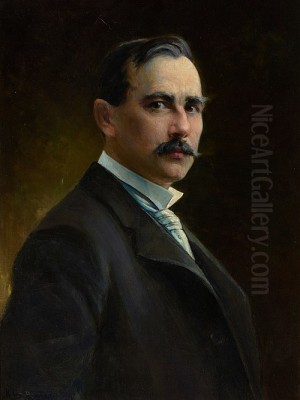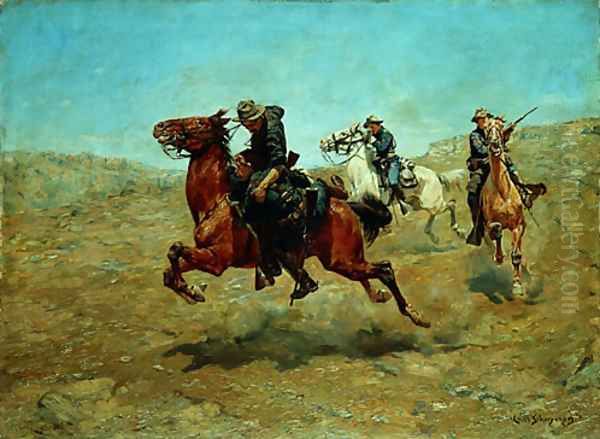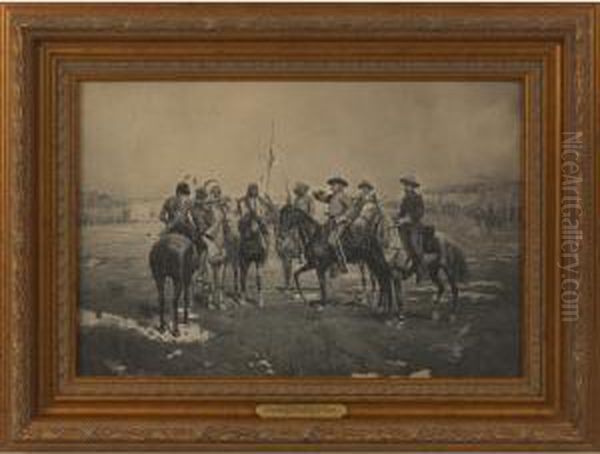
Charles Schreyvogel stands as a pivotal figure in the canon of American Western art. Active at the turn of the 20th century, he captured the dramatic intensity and fading romance of the American West, particularly focusing on the U.S. Cavalry and their interactions with Native American peoples. His work, characterized by its meticulous detail, dynamic action, and emotional depth, provides a vital, if sometimes romanticized, visual record of a transformative period in American history. Though his career was relatively short, his impact was significant, placing him alongside other giants who sought to define the Western experience in art.
Early Life and Artistic Awakenings
Born on January 4, 1861, in New York City, Charles Schreyvogel was the son of German immigrant parents. His family later relocated to Hoboken, New Jersey, where he spent his formative years. From a young age, Schreyvogel displayed a burgeoning interest in art, though his family's modest means meant that a formal artistic education was not immediately forthcoming. His early life was marked by financial struggles, a theme that would recur throughout much of his career.
Initially, Schreyvogel found employment in various trades, including working as an apprentice to a die-sinker and later in a lithography shop. These experiences, while not directly fine art, likely honed his eye for detail and draftsmanship. A turning point came through the encouragement of a fellow artist of German descent, H. August Schwabe. Recognizing Schreyvogel's raw talent, Schwabe urged him to pursue formal art training and may have provided some initial instruction. This support was crucial in setting Schreyvogel on the path to becoming a professional artist.
His early artistic endeavors in the Eastern United States met with limited success. The prevailing tastes in the art markets of New York and other Eastern cities did not always favor the Western themes that were beginning to captivate Schreyvogel's imagination. However, his passion for the West, fueled by popular accounts and burgeoning visual culture surrounding the frontier, was undeniable.
European Sojourn: Honing Skills in Munich

Like many aspiring American artists of his generation, Schreyvogel recognized the importance of European academic training to refine his skills. In the 1880s, specifically from 1887 to 1890, he managed to save enough money, possibly with the help of patrons, to travel to Germany. He enrolled in the prestigious Royal Academy in Munich, a major center for art education that attracted students from across Europe and America.
In Munich, Schreyvogel studied under notable artists such as Carl von Marr, an American-born painter who had become a prominent figure in the Munich art scene, and Frank Kirchbach. The Munich School was renowned for its emphasis on realism, strong draftsmanship, and often dramatic, narrative compositions. This environment profoundly influenced Schreyvogel's technical abilities, particularly his handling of anatomy, dynamic action, and detailed rendering. It was also during this period that he began to seriously consider the artistic potential of American Western themes, a subject that was exotic and compelling to European audiences as well.
His time in Munich provided him with the technical foundation upon which he would build his career. He learned to construct complex figural compositions and to imbue them with a sense of immediacy and drama, skills that would become hallmarks of his Western paintings. Despite the European setting, his artistic vision remained firmly rooted in the narratives of his homeland.
The Call of the West: Firsthand Experiences
Upon his return to the United States, Schreyvogel continued to struggle financially. However, his fascination with the American West only intensified. He understood that to authentically portray this subject, he needed firsthand experience. He was particularly captivated by the stories and imagery associated with the U.S. Cavalry and the Plains Wars, a period of intense conflict and cultural collision that was, by the 1890s, drawing to a close.
A significant opportunity arose in 1893. Reportedly suffering from ill health, Schreyvogel was advised to seek a drier climate. This led him to travel to the American West, specifically to Arizona and Colorado. He spent time on the Ute Reservation in Colorado, an experience that proved invaluable. He immersed himself in the environment, learning to ride horses and even acquiring some knowledge of Native American sign language. This direct contact with the landscapes, people, and remnants of frontier life provided him with a wealth of authentic details and a deeper understanding of his chosen subject matter.

He also made subsequent trips, including to Montana, visiting areas associated with the Blackfeet (Pikuni) Nation. These journeys allowed him to sketch, take photographs, and collect artifacts – clothing, weaponry, and accoutrements of both soldiers and Native Americans. This dedication to accuracy became a defining characteristic of his work, lending his paintings a sense of verisimilitude that resonated with audiences. He was not merely imagining the West; he was actively seeking to understand and record it.
Another crucial influence during this period was the rise of Wild West shows, particularly "Buffalo Bill" Cody's spectacular productions. These shows, immensely popular both in America and Europe, shaped public perception of the West and provided artists with living models and dramatic scenarios. Schreyvogel was known to have been deeply impressed by these performances and even used some of the Native American performers as models for his early paintings, further bridging the gap between romanticized notions and tangible reality.
"My Bunkie" and the Dawn of Recognition
For years, Schreyvogel labored in relative obscurity, his Western paintings failing to find a significant market in the East. The breakthrough came dramatically in 1900. He submitted a painting titled My Bunkie to the annual exhibition of the National Academy of Design in New York. The painting depicts a chaotic battle scene: a cavalry trooper, his own horse presumably shot, is being rescued by a comrade who reaches down to pull him onto his galloping mount, all while under fire from unseen Native American warriors.
The painting was an immediate sensation. Its dynamic composition, palpable sense of urgency, and heroic subject matter captivated both critics and the public. My Bunkie was awarded the prestigious Thomas B. Clarke Prize by the National Academy, an honor that catapulted Schreyvogel from obscurity to national fame almost overnight. This recognition was a turning point in his career, validating his artistic vision and finally bringing him the acclaim he had long sought. In 1901, he was elected an Associate of the National Academy of Design, a significant professional milestone.
The success of My Bunkie (now in the collection of the Metropolitan Museum of Art, New York) cemented Schreyvogel's reputation as a leading painter of Western action scenes. It opened doors to commissions and sales, though financial security remained a persistent challenge for the artist throughout his life.
Artistic Style and Thematic Concerns

Schreyvogel's artistic style is characterized by its vigorous realism and a keen sense of dramatic narrative. He specialized in "arrested motion," capturing figures—men and horses—at the peak of action, often in perilous situations. His compositions are typically dynamic, with strong diagonal lines and a focus on the intensity of the moment. He paid meticulous attention to the details of military uniforms, weaponry, horse tack, and Native American attire, a testament to his research and the collection of artifacts he maintained in his Hoboken studio.
His primary theme was the conflict between the U.S. Cavalry and Native American warriors on the Great Plains during the latter half of the 19th century. Works like The Summit Springs Rescue (also known as The Rescue of Corporal Scott) or Saving the Dispatch showcase the bravery and peril faced by soldiers. While his perspective often centered on the cavalry, Schreyvogel was also noted for portraying Native Americans with a degree of dignity and prowess, even as adversaries. Paintings such as The Silenced War Whoop or A Close Call depict them as formidable warriors defending their way of life.
Unlike some of his contemporaries who might have focused more on the daily life of the cowboy or the grandeur of Western landscapes, Schreyvogel was preeminently a painter of action and conflict. His canvases often explode with energy, the dust of battle, the strain of exertion, and the imminent threat of death. He aimed to place the viewer directly into the heart of the fray, creating an immersive and often visceral experience. His use of firearms, for instance, was not merely incidental but a key visual element that heightened the drama and historical specificity of his scenes.
While his work celebrated the perceived heroism of the cavalry, it also, perhaps inadvertently, documented the tragic and violent nature of westward expansion. Some modern interpretations also note an underlying sympathy for the Native American predicament, even if filtered through the lens of the era's prevailing attitudes. He depicted the "vanishing frontier," an idea laden with nostalgia and a sense of loss, even as it often glorified the forces of that transformation.
Notable Works: A Portfolio of the Frontier
Beyond My Bunkie, Charles Schreyvogel produced a significant body of work that further explored his key themes. Each piece contributes to our understanding of his artistic vision and his portrayal of the West.
The Last Drop (1903): This is one of Schreyvogel's notable forays into sculpture. The bronze piece depicts a cavalryman tenderly offering the last drops of water from his canteen to his exhausted horse. It’s a poignant portrayal of the bond between soldier and animal, and the harsh conditions of campaigning on the arid plains. This work showcases his versatility across media and his ability to convey emotion through three-dimensional form.
Attack on the Herd (c. 1902): This painting captures a dynamic scene of Native American warriors raiding a cattle herd, likely guarded by cowboys or soldiers. The composition is filled with movement, the thundering hooves of cattle and horses kicking up dust. It contrasts with some of Frederic Remington's more static or composed cattle scenes, emphasizing Schreyvogel's preference for high-octane action.
A Fight to the Finish (or similar titles depicting intense combat): Schreyvogel created several works focusing on desperate, close-quarters combat. These paintings often feature a small group of soldiers or a lone individual fighting against overwhelming odds, or intense skirmishes between Native American warriors. The raw energy and life-or-death struggle are palpable, highlighting his skill in depicting human figures under extreme duress.
White Eagle (1899): This was reportedly Schreyvogel's first bronze sculpture, predating The Last Drop. It depicts a Native American warrior, likely a chief or prominent figure, exuding a sense of pride and defiance. This piece underscores his interest in portraying Native American subjects with a sense of individual character and strength.
Custer's Demand: This painting depicts a tense parley between General George Armstrong Custer and Native American leaders. It’s a more narrative and less action-oriented piece compared to his battle scenes, but still charged with underlying tension and historical significance.
Saving the Colors: Another classic cavalry scene, this work would have focused on the heroic act of preventing the regimental flag from falling into enemy hands during a battle—a theme rich with patriotic and dramatic potential.
These and other works are held in prestigious collections, including the Gilcrease Museum in Tulsa, Oklahoma; the Amon Carter Museum of American Art in Fort Worth, Texas; the Buffalo Bill Center of the West in Cody, Wyoming; and the Denver Art Museum, among others.
Schreyvogel and His Contemporaries: A Shared Canvas
Charles Schreyvogel was part of a significant wave of artists who turned their attention to the American West at a time when the frontier was rapidly disappearing. His work can be understood in dialogue with several key contemporaries and predecessors.
The most prominent contemporary with whom Schreyvogel is often compared is Frederic Remington (1861-1909). Both artists were born in the same year and became famous for their depictions of Western action, particularly involving cavalry and Native Americans. Remington, however, achieved fame earlier and had a broader output, including illustration, writing, and sculpture. While both excelled at action, Remington's style sometimes leaned more towards illustration with a more polished, almost "cooler" finish, whereas Schreyvogel's paintings often convey a more raw, "you-are-there" intensity and a slightly rougher, more painterly texture. Both artists meticulously collected artifacts to ensure accuracy in their depictions.
Another major figure was Charles M. Russell (1864-1926), the "Cowboy Artist." Unlike Schreyvogel or Remington, Russell lived much of his life in the West (Montana) and had firsthand experience as a working cowboy. His work, while also featuring action and Native Americans, often had a more anecdotal, storytelling quality, with a deep empathy for the cowboy and a nostalgic view of the passing frontier. Schreyvogel’s focus was more narrowly on the military aspect of the West.
These three artists—Remington, Russell, and Schreyvogel—are often considered the triumvirate of early Western art, each bringing a distinct perspective.
However, the tradition of depicting the West had earlier roots. Artists like George Catlin (1796-1872) and Karl Bodmer (1809-1893), working decades earlier, provided invaluable ethnographic records of Native American life before it was drastically altered by westward expansion. Alfred Jacob Miller (1810-1874) also documented the fur trade era and Native American life in the Rocky Mountains. These artists laid a foundation for later painters by establishing the West as a legitimate and compelling subject for American art.
The grand Western landscapes of Albert Bierstadt (1830-1902) and Thomas Moran (1837-1926), while different in focus from Schreyvogel's figure-driven narratives, contributed to the romantic allure of the West and established its epic scale in the American imagination. Schreyvogel's figures often acted out their dramas against backdrops suggestive of these vast, arid plains.
Other contemporaries who depicted Native American subjects, often with a more focused ethnographic or sympathetic lens, include Henry Farny (1847-1916) and Joseph Henry Sharp (1859-1953), the latter becoming a key figure in the Taos Society of Artists. While Schreyvogel's Native Americans were often antagonists in military dramas, these artists frequently portrayed them in more peaceful, everyday settings, or with a poignant sense of their changing world.
The influence of the "Golden Age of Illustration" (roughly 1880s-1920s) is also relevant. Artists like Howard Pyle (1853-1911) and his student N.C. Wyeth (1882-1945), though often working in historical or adventure genres beyond the West, shared Schreyvogel's commitment to dramatic narrative, historical accuracy, and dynamic composition. The public appetite for illustrated stories in magazines like Harper's Weekly and Century Magazine helped create a visual language that Schreyvogel's paintings tapped into.
Even European academic painters, such as the French artist Jean-Léon Gérôme (1824-1904), known for his meticulously detailed historical and Orientalist scenes, represented the kind of technical polish and narrative clarity that artists trained in Munich, like Schreyvogel, would have been exposed to and influenced by. The American narrative painter Winslow Homer (1836-1910), with his powerful depictions of the Civil War and scenes of American life, also shared a commitment to realism and impactful storytelling.
Later Years, Legacy, and Enduring Influence
Despite the fame brought by My Bunkie, Charles Schreyvogel continued to face financial difficulties throughout his career. He worked diligently in his Hoboken studio, which was famously located on the rooftop of an apartment building to maximize light. He produced a steady stream of paintings and a few sculptures, many of which were reproduced as popular prints, further disseminating his images of the West.
In 1909, he was elected a full Academician by the National Academy of Design, a further testament to his standing in the American art world. However, his career was tragically cut short. Charles Schreyvogel died on January 27, 1912, in Hoboken, New Jersey, from blood poisoning stemming from complications related to kidney stones. He was only 51 years old.
Schreyvogel's legacy is that of an artist who vividly and dramatically captured a specific, tumultuous chapter of American history. His work, along with Remington's, largely defined the popular image of the U.S. Cavalry in the West. He brought an Easterner's eye, trained in European academic traditions, to a uniquely American subject, creating images that were both historically grounded and theatrically compelling.
His paintings are valued for their energy, their attention to detail, and their ability to convey the intensity of conflict. While modern perspectives may critique the romanticization of warfare or the stereotypical portrayals inherent in the genre, Schreyvogel's work remains an important document of how the "Wild West" was perceived and mythologized at the turn of the 20th century. He provided a visual narrative that resonated deeply with a nation grappling with the closure of its frontier and the meaning of its westward expansion. His art continues to be studied and appreciated for its technical skill and its powerful evocation of a bygone era.
Conclusion: An Artist of Impact
Charles Schreyvogel, in his relatively brief but impactful career, carved out a distinct niche in the world of American Western art. He was a storyteller in paint, a dramatist of the frontier conflict. His canvases, filled with the thunder of hooves, the crack of rifles, and the desperate courage of men in battle, offer a compelling, if specific, vision of the American West. From his humble beginnings and through dedicated study and firsthand experience, he rose to national prominence, leaving behind a body of work that continues to engage and fascinate audiences, securing his place as one of the foremost painters of the American frontier. His dedication to capturing the "vanishing West" ensures that his art remains a vital part of America's cultural and historical memory.